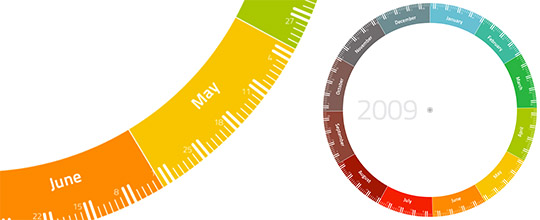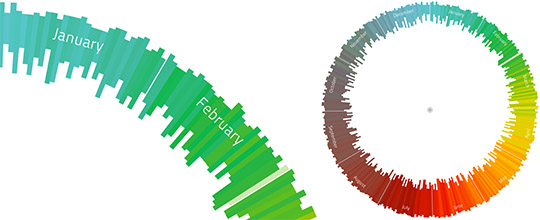Year Clock
The idea of a Year Clock or circular calendar has been around for quite some time, but actual implementations are uncommon.
In the past, I have discussed how well it illustrates the calendar, and helps visualise and conceptualise long time periods (which I've never been too great at). So, in July 2009 I decided to make one.

Graphics
Design
Early versions of the graphics contained quite detailed calendar data.

Later I substituted this with more extensive use of colour; putting care into the color semantics to communicate the seasonal feel of the months.

Creation
Because the graphics are highly detailed and variable; rather than draw multiple versions by hand, I wrote a Ruby script to dynamically generate images.
Given any year, this program uses Ruby’s date class and XML builder to generate SVG files, which I then refined using Adobe Illustrator.
Prototyping
I made my prototype from a hacked IKEA SKARP clock. Replacing the face with my own design, and the three hands with a single, laser-etched acrylic year-hand.
Electronics
I turned to my Arduino after reading an article by Matt Mets about controlling a clock mechanism. By rewiring the clock mechanism, and programming it to tick once every 730 seconds, the hour-hand gear makes one revolution in 365 days.
Development
Graphics
The graphics are specific to a certain year (because of the dates of weekends and leap days). Meaning the clock face must be replaced yearly. This is impractical, so in further redesigns I will abstract the calendar data to make one version applicable to any year.

After all, calendars do a perfectly good job of communicating numerical dates. The Year Clock is intended to help visualise the feel of seasons and passing time.
Design
I will also take this project from a work mainly of two-dimensional infographics into three-dimensional product design.
Electronics
An Arduino uses a lot more power than a clock mechanism's electronics. So the current prototype requires an external power supply. But hopefully I can engineer a battery-powered circuit.
